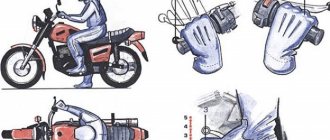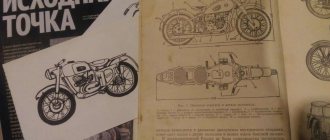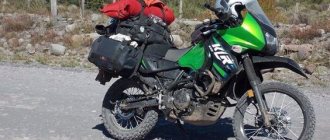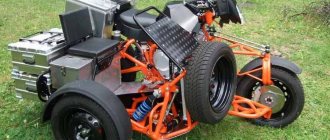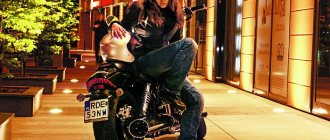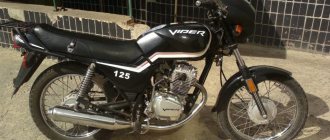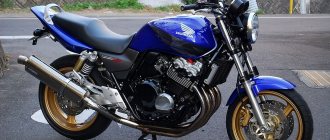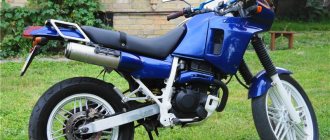There are situations when the motorcycle's electrical system partially fails and the warning lights stop working. At the same time, it is almost pointless to stop driving - it is quite possible that the nearest store or service station is still several dozen kilometers away, and it will not be possible to get there any other way. The situation is saved by the gestures of motorcyclists, regulated by the Rules - they allow you to do without turn indicators and brake lights for some time. However, gestures are used not only for this purpose - for example, international biker associations have developed signaling systems that are quite simple and understandable to everyone for communicating on the go. Any motorcyclist should also know them - this will greatly facilitate mutual understanding when riding in a group or convoy.
Standard gestures
The current rules require the use of only three official gestures. It is worth understanding that they are applied exclusively with the left hand - the right one must always be on the gas handle and control the brake lever. This applies not only to standard gestures, but also to informal signals that motorcyclists give to each other.
The most important gesture is the arm raised vertically without bending at the elbow. In this case, the motorcyclist's palm should be fully open to improve the visibility of the signal over a long distance. If we are talking about driving at dusk, it is better to use gloves with reflective inserts or wrap them with light fabric. This gesture means serious braking or a complete stop - it is a replacement for the brake light.
The motorcyclist's arm extended to the left indicates that it is in this direction that he is about to make a turn. However, what about right-hand turns? Since it is prohibited to lift your right hand from the steering wheel, to signal such a change in direction of movement, you should raise your left hand, bending it at the elbow and turning your palm with its edge towards the vehicles driving behind you. Such signals, given by the motorcyclist’s hand, will help to avoid an accident and get to the repair site without the slightest problem.
But it is better not to resort to such gestures, since their effectiveness is still much lower than that of signal electric lamps. Therefore, it is better to purchase a special device, which consists of an electronic control unit and a battery. If the electrical circuit breaks, it will automatically switch the power to the light bulbs to the built-in battery, which will allow you to get to the nearest repair point without experiencing any inconvenience. In this case, the driver will not be able to ignore the problem - a special warning lamp on the device will indicate its presence.
"Chess" and the rules of riding in a convoy.
What could the 99% of us do? The formation of the column began to change, and outgrew the well-known “chess” order. This is convenient, but if you do not follow certain driving rules, you can not only get injured, but also cause irreparable damage to others (not just the column). 1) The column is built: 2, 2, 2, etc. 2) I think there is no need to explain what the “chess” order is. Motorcycles are positioned so that all participants have the opportunity to maneuver towards the neighboring motorcycle.!!! 3) In the column, everyone rides in his “place”!!! 4) Any changes in the column are prohibited!!! 5) Motorcycles are kept at such a distance from each other that no car passes between the motorcycles. But don’t forget that the distance should be enough for braking, not to mention emergency situations!!! 6) If the green traffic light ahead has been on for a long time, the column slows down because the column must pass completely under one signal. 7) The leader is obliged to block traffic when leaving or turning the column onto the highway. Including road intersections, see point 6 8) The fastest vehicle becomes the closing motorcycle, because if the leader in the column, say, goes at a speed of 100 km/h, the trailing ones go 120 km/h 9) When overtaking on the highway, the leader turns on the turn signal, and the column lines up in one line after overtaking everyone falls into place 10) The trailing ones, so They block the traffic and make sure that no one lags behind. Cut off extraneous transport from the column. If necessary, or if any breakdowns or necessary refueling occur, they overtake the convoy and, catching up with the Leader, report the reason for the necessary stop and reduction in speed. Gestures installed in the column especially for this purpose.!!!
All steering should be smooth and precise. You should do most steering and lane changes without removing your hands or the wheels. You should be able to steer in a straight line by moving gears, adjusting controls, or checking your blind spot.
Using turn signals and brake lights
Show the steering wheel like a clock and place your hands at nine o'clock and three o'clock. Signals tell other drivers what you want to do, alerting them to your intention to turn or stop. Use turn signals and brake lights to signal before stopping, slowing down, turning, changing lanes, leaving the road, or leaving a parked position. Give the right signal before taking action and make sure other drivers can see it. Before you act, make sure that the path is impossible, just signaling is not enough.
if one stops and does not indicate that everyone can move on, the entire column stops.
Informal gestures
However, traffic signals do not allow motorcyclists to communicate with each other without slowing down. Therefore, biker associations are developing their own signaling systems based on special gestures. Of course, in individual organizations the meaning of gestures may vary, with the total number reaching hundreds. In this article we will consider only universal gestures that will be equally understood in any country in the world and will not cause any conflict situations or misunderstandings.
Hand signals can be given not only while moving, but also before moving. The left arm bent at the elbow with the index finger extended means readiness - if the team leader gives such a signal, everyone should put on helmets, check their equipment, make sure there is enough fuel, and, if necessary, let other team members know about problems. If you make several rotations with your index finger counterclockwise, this will indicate the need to start and warm up the engines. Next, you need to decide on the mode of movement - a palm raised obliquely above the head (pioneer greeting) means that motorcyclists are lined up in one column, and the index and middle fingers pointed upward (peace sign) - in two columns. The signal to start moving is a sharp swing of the left hand from bottom to top, and while moving it also means the need to speed up.
In addition, a quick swing of the left hand with the palm raised up means that the vehicle driving behind can overtake the motorcyclist without the slightest hindrance. On the contrary, if the palm is lowered up and the motorcyclist makes movements from top to bottom, this means that overtaking will be dangerous or he himself is going to get ahead and asks to let him pass so as not to create an emergency situation. A smooth movement of the left hand from top to bottom will indicate that the column of motorcyclists must slow down to avoid the danger presented by a bad road or a traffic police post. If the driver who is driving next to you forgot to turn off the turn signal, you need to form a circle with your thumb and index finger (OK sign), and close and open the resulting circle several times. If you find a dangerous object on the road, you should point at it with the index finger of your left hand or your right foot - this is what you do if you see an obstacle, a hole or other obstacle that could cause a significant problem.
In many situations, motorcyclists have to stop because the movement cannot continue indefinitely. If there are no special reasons for this, but a stop is still required, for example, for negotiations or for sightseeing, you should lower your left hand down at an angle of about 45 degrees and point your palm in the direction of travel. If there is a certain reason, the stop signal is given by placing the elbow to the side and extending the thumb, which should point in the desired direction:
- You need a snack - your thumb points to your mouth (to your helmet);
- You need to rest or the motorcyclist is not feeling well - the finger is pointed at the chest;
- You need to refuel - your finger points to the tank.
When the column has stopped, you should make a sharp movement with your arm bent at the elbow from left to right - this will mean that all riders must turn off the engines.
However, it is worth understanding that the peculiarities of the national culture of some countries do not allow the use of certain signals from motorcyclists, so you should carefully read this information when setting off on a long journey. In the USA, a raised index finger along with a protruding thumb means that a person considers the interlocutor a loser, so local bikers will not be at all happy to see such signs. In Greece, you need to make gestures with any fingers except the thumb, since raising it means obscene swearing, but a fully open palm with fingers spread will show that you want to call the Greek a “pindos”. The peace-loving gesture with the index and middle fingers spread to the side in the countries of the former British Empire (Great Britain, Australia, Canada, New Zealand, India, Hong Kong) means the same as the middle finger in other cultures, and the fingers brought together in a ring in the OK symbol are an accusation a person of non-traditional sexual orientation. Of course, these traditions are gradually becoming a thing of the past thanks to globalization, but you still have the chance to get yourself into a stupid position by going abroad.
A little history.
Why exactly a column, why exactly 2 people in a row, why “chess” order. Initially, the column was intended to accompany persons occupying a certain position in society. These could be officials, bankers, etc. When the first MC clubs appeared, namely Hels Angels, they are also the founders of the Charter of MC clubs (at that time MG, the history can be read, this construction was necessary to preserve the life of the President of the club. Then the column was built in this way: 1, 2, 2, etc., but the motorcycles did not walk in a “chessboard” order, but next to each other, which made it possible to reduce the risk of a bullet hitting. When turning, the column also covered the Leader with its tail. It should be noted that even today MC clubs preserve this tradition. But this construction of a column is prohibited and a license is required for it, because it is considered a motorcade. So, we seem to have sorted out the story, and to the question of why 2 also answered, let's move on.
Always be aware of the traffic around you when you drive. Develop a routine for searching forward, behind, and side to side. Check your mirrors every five seconds or so, and check your blind spots by turning your head to look over your shoulder. Keep other drivers out of your blind spot by changing your speed and avoiding other vehicles. This is especially true when driving around large commercial vehicles, as they typically have large blind spots to and from the sides.
Be especially careful at dusk and dawn when everyone has difficulty adjusting to the changing light. Keep a cushion of space around your vehicle and be prepared for the unexpected. Anticipate other drivers' movements and take into account any possible errors. Look ahead and watch people in parked cars; they may be about to jump out in front of you or open the door. Watch out for smaller vehicles, bicycles and pedestrians.
Using Gestures
Of course, modern technology helps to cope with problems with electrical circuits in a motorcycle, but its potential is also not unlimited. Therefore, every driver should know the official gestures prescribed by the traffic rules. In addition, bikers who often ride in groups should also learn non-standard sign language, which helps communicate even on the go. Its use will help avoid unpleasant situations and accidents, as well as synchronize the start of movement, acceleration, deceleration and stopping. Using informal sign language, you can receive a danger signal from another biker or give him a similar warning.
Hand signals in traffic rules
Hand signals are described in the second paragraph of paragraph 8.1 of the traffic rules:
The signal for a left turn (turn) corresponds to the left arm extended to the side or the right arm extended to the side and bent at the elbow at a right angle upward. The right turn signal corresponds to the right arm extended to the side or the left arm extended to the side and bent at the elbow at a right angle upward. The brake signal is given by raising your left or right hand.
There are 3 types of signals:
- left turn (turn);
- right turn;
- braking.
Let's look at a few images to help you understand how a particular signal should be sent:
| Signal | Meaning |
| Turn left or make a U-turn | |
| Right turn | |
| Braking |
Position of the motorcyclist on the roadway
The location of the motorcycle on the roadway - whether you move on the inside of the lane or on the outside, or perhaps in the center - is influenced by many different circumstances, both your intentions and the situation on the road at a given time.
This could be your desire to better see the situation on the road, or foreign objects on the road or defects in the road surface, information from other similar motorcyclists that they will now stop or turn, or side winds or air currents from other vehicles - buses or trucks.
Various factors can hinder traffic on the roadway. Let's roughly divide them into three groups. 1. These are moving objects. This includes motorcycles, cars and bicycles. Although their movement seems to be rectilinear and uniform, the trajectory of movement is quite predictable, but you still need to always keep them in mind. 2. These are also moving objects, but now they are pedestrians. These could be children or animals, as well as persons in a not entirely sober state. Their movement is much slower than that of vehicles, but differs in that it is almost impossible to predict them and they can move short and quickly. 3. Objects that are without movement. These are fences and curbs, poles and cars, hatches, both open and closed, etc. Although these objects are unlikely to be able to cross the road in the wrong place, as well as in the right place, coupled with all the above mentioned obstacles, they can affect the criticality of the traffic situation that has arisen.
In addition to the fact that you see all this, it is equally important that you are visible too. Indeed, according to statistics, 50 percent of accidents involving motorcyclists occur only because other drivers simply did not see them, just before the very moment when the accident occurred
As we have already said, a motorcycle is much smaller in size than its four-wheeled counterparts, and as a result, it is more difficult to identify it in a stream of rushing traffic and correctly estimate its speed. Some motorcyclists, perhaps unconsciously, camouflage themselves even more - they do not wash their two-wheeled friend, wear dark-colored clothes and do not turn on their headlights. But you need to do exactly the opposite - wear bright clothes and a helmet, drive with headlights on even during daylight hours. All this will serve as additional active elements of your safety.
Don't forget that all the warning devices on your motorcycle must be in good working order - be it the horn, brake light or turn signal. In some driving situations, it is necessary not only to turn on the turn signal, but also to duplicate this intention with your hand. This is necessary, for example, if you want to change lanes to the left or make a U-turn
Raising your hand immediately attracts the attention of other road users and makes it possible to avoid an absurd accident. Before you brake, flash your brake lights several times - a flashing light attracts more attention than a continuously lit light.
In order for you to be clearly visible among other vehicles in its flow, you need to take the right position in it. You should not move in the same lane as a bus or truck, or maneuver in heavy traffic for no apparent reason. As you gain experience, you will no doubt learn how to do all this, but while you are a novice motorcyclist, try to ride as safely as possible. Try not to have cars pressing close to you - this will give you the necessary time to find the necessary trajectory to get out of a difficult situation in traffic. You may be able to do this safely later when you gain skill and experience, but for now, try to create an exclusion zone around yourself. This will help you not only see the traffic situation yourself, but will give you time to find a backup route in an emergency.
The choice of lane directly depends on the situation on the road. You should not press too hard against the vehicle in front - this constantly keeps you in suspense and it is easy to run into a foreign object that the car can easily pass between the wheels, for example a large stone or an open hatch. Here you can use a fairly well-known rule - divide the speed at which you are moving by two and get the required distance in meters. Of course, in city conditions this is not always possible, but you should maintain as much distance as possible. Try not to let those driving behind you get too close to you - flash your brake light a couple of times, let them slow down a little and thereby increase the distance.
Timoshenko Andrey
When should a driver give hand signals?
Let's consider the first paragraph of clause 8.1 of the traffic rules:
8.1. Before starting to move, change lanes, turn (U-turn) and stop, the driver is required to give signals with turn signals in the appropriate direction, and if they are missing or faulty, with his hand. When performing a maneuver, there should be no danger to traffic or interference with other road users.
Turn signals must be used in the following cases:
- before starting the movement;
- before rebuilding;
- before turning or turning;
- before stopping.
Hand signals replace turn signals. They should be used if the turn signals are faulty or missing altogether on the vehicle.
For example, turn signals are not installed on bicycles and some mopeds.
Please note that traffic rules do not oblige the driver to give a brake signal. That is, the hand signal itself is described in the rules, but the situations in which it should be used are not.
At what point is the hand signal given?
Let us turn to clause 8.2 of the Rules:
8.2. The turn signal or hand signal must be given well in advance of the maneuver and cease immediately after completion (the hand signal may be terminated immediately before the maneuver). In this case, the signal should not mislead other road users.
You need to start giving a hand signal in advance so that other road users have time to understand what maneuver you have planned.
It is allowed to stop giving the signal immediately before the start of the maneuver, that is, before turning the steering wheel.
Note. You should not give a hand signal while turning, because... Driving a vehicle with only one hand is inconvenient and can lead to an accident.
Tip #3 – Don’t race between cars
"Attention! Motorcycles are everywhere » Motorcycles usually travel faster on the road than cars, so they can flash in the driver's mirror without him noticing the rider. Unfortunately, the consequences of this situation can be tragic
Therefore, a prudent motorcyclist will ride so that others can see him
The motorcyclist should always be aware that the driver of the car may not be able to see him in the rear view mirror - it is important to maintain an appropriate safe distance from the vehicle, avoid and, if necessary, adjust the speed. The so-called principle of limited confidence, because due to inattention, lack of sufficient visibility or ordinary human stupidity, an inattentive driver can change lanes into a motorcyclist when changing lanes
Traffic signs driving in lanes
Sometimes traffic rules signs make driving in lanes clearer and simpler, in other cases they make it more complicated. Problems arise more likely from those who do not know how to read them. What symbols can be used:
- 5.15.1. Indicates which of several lanes you can drive from it to the right, straight and to the left, from where you can turn around. The direction is easy to understand by the arrows.
- 5.15.2. There are several of these symbols. And each indicates one or two permitted directions. If the symbol is on the leftmost lane, it allows a turn in the same direction, under it you can change the trajectory by 180 degrees.
- 5.15.3. Shows the starting point of a new row for cars. The latter may be intended for braking or begin on an ascent. The symbol indicates an additional lane; traffic regulations require it to be used in different ways.
If there is a speed limit on it, you cannot drive faster from here to the end of the coverage area. This usually happens in the braking zone. First they change lanes, only then reduce speed. If we are talking about an acceleration lane, they speed up the car on it, change lanes to the next one, not forgetting to let those who were already driving there pass.
- 5.15.4. It means the same as the previous symbol, but is installed where the central stripe begins (and there are two more on the sides).
- 5.15.5. Completes the acceleration section or climb.
- 5.15.6. It is installed where the central part of a three-lane road disappears.
- 5.15.7. Indicates which direction the movement is directed, and is necessary if there are more paths leading into one of them than towards them.
- 5.15.8. Shows the number of lanes and the speed limit for each.
The symbols may not be observed by public transport, but they are mandatory for everyone else.
Tips for the passenger
* Since I am also sometimes a passenger myself, it is worth raising one point. Do you trust the driver? The point is not that this is your uncle, dad or school friend with whom you drank vodka. The point is, do you trust this person as a motorcyclist? When in doubt, consider whether it is worth risking your life. This is not an exaggeration, this is your life, because a motorcycle is a dangerous toy. Unfortunately, there are many boys in the world who do not know how to use it correctly.
*Have you noticed how often motorcycle accidents are reported where the passenger's helmet comes off? People unfamiliar with helmets don't know how to strap them on. If you are such a person, take a simple test. Secure the strap under your chin, then grab the back of the helmet and simultaneously pull forward and upward toward your chin. If you can remove it, the helmet is loose or does not fit properly.
* If you have high boots with laces, make sure the laces are pulled tight and preferably make two knots. You certainly don't want them to come loose while riding and end up in your rear wheel...
* Gloves should be leather, your size, and fit tightly around your wrists. It's not about being pretty, it's about protecting you in case of an accident. Man reflexively protects his head and props up his arms
That's why it's so important that your gloves are neat and form-fitting
* Are you going to ride a motorcycle with someone? This is great, the experience will definitely be unforgettable, but how long will you be a “backpacker”? How many hours on the road, how many times will you stop, what roads will you travel on? Are you planning to drive through the city, or maybe just the highway? Keep in mind that even on hot days, the rush of air cools the body. This is why attire and frequent stops are important.
Make sure the rider is aware of your needs and take care of the correct equipment.
* Learn how to sit on a motorcycle, where to place your feet, what not to touch under any circumstances, how to communicate on the road - because you almost certainly will not be able to talk.
* The passenger must not disturb the motorcycle driver. Beginning “backpacks” tend to verticalize the figure. This is mistake. The passenger should not oppose the movement of the motorcyclist's body; this is especially dangerous when cornering. Try to stay close to the driver, duplicate his moves and everything will be fine.
* Never place your feet on the ground - during a temporary stop at a traffic light or in other circumstances, unless the motorcycle driver asks you to do so.
* Don't panic if you hear a loud noise around the motorcycle's chassis. This effect mainly appears when turning.
* Learn to relax while driving and enjoy it. The art of riding as a passenger is also about letting go of the car and the driver.
* If you are uncomfortable, cold, not feeling well, something is wrong, you must inform the rider. Use the symbol system you have chosen to stop and explain what is happening. Never try to solve a problem while driving.
* Finally. Always remember that you are a passenger, even if you have experience riding a motorcycle. It's a bit like an airplane where there are two pilots, but there is only one captain. The worst thing that can happen to a motorcyclist is a passenger who wants to "help" him because he knows better. Remember, you are sitting in the back, you are a backpack, even if your name is Valentino Rossi.
It's worth remembering these tips. These are the simple things that usually slip through the cracks when two people spontaneously decide to travel together. That's why it's good to remember the tips before getting on a motorcycle together. Riding together is a fantastic experience, and anyone who has carried a woman on their steel horse knows how much fun it is. Just don't let emotions replace reason. This last tip also applies to “backpacks”. See you on the roads!
Post Views: 426
MotoNoob.ru
Which hand is better to signal a turn?
Above it was said that each of the turn signals corresponds to 2 gestures. Let's figure out which gesture is best to use in a given situation.
By bicycle, motorcycle, moped
When driving a two-wheeled vehicle, it makes sense to use signals that are given with an outstretched arm:
It is much easier for other traffic participants to understand such signals. While the arm bent at the elbow puts some drivers into a stupor.
By car or bus
When driving a vehicle with a cab, the situation is different. The driver cannot give signals with his right hand, because it simply does not reach the right window across the entire cabin. Therefore, it remains to use signals given by the left hand:
Note. If the car has a right-hand drive, then all signals are given with the right hand through the right window.
Fines
Traffic signs for motorcycles are no different from other road signs, and violation of their requirements can also lead to administrative liability for the violator.
Thus, according to Part 1 of Article 12.16 of the Code of Administrative Offenses of the Russian Federation, for violating the requirements of sign 3.5, the driver may be limited to either a warning or receive a fine of 500 rubles.
As is the case with other signs, violation of the requirements of sign 3.5 can lead to other violations associated with the creation of an emergency situation on the road. Then the amount of the fine may increase to 1,500 rubles.
The motorcycle driver must keep in mind that Article 12.6 of the Code of Administrative Offenses also provides for a fine for driving without a helmet - 1,000 rubles. Moreover, if a passenger is transported, he must also have a helmet on his head.
Do not forget that a motorcyclist has the opportunity to appeal the actions of the State Traffic Inspector in the event of an unlawful fine being imposed. Here, the reason may be either poor visibility on the road or violation of the rules for installing a road sign.
The latter case gives the driver a great advantage in a dispute with the traffic police, especially if the fact of violations when installing a sign is recorded on a photo or video camera/recorder. If the driver believes that his rights have been violated, a complaint can be submitted to the head of the traffic police department or directly to the court
But it is important to remember that in court you will have to have a good evidence base to prove your case. According to the current legislation, 10 days are given to appeal the protocol
Exceptions
The traffic rules provide for a number of exceptions under which motorcyclists can drive under this sign. These are motorcycles that belong to the federal postal service.
A motorcycle serving post office must have an identification mark in the form of a white diagonal stripe on a blue background. It is usually applied to the side of the motorcycle.
Also, motorcycles that are attached to or serving enterprises, as well as objects located in the area where the sign is valid, can pass under the sign. Or, the owners of these motorcycles live in houses on their territory. In this case, motorcycle drivers must enter the area covered by the sign and leave it at the intersection closest to this location. Moreover, if the drivers of these vehicles serve organizations or other objects, they must have the appropriate documents with them (certificate, certificate certified by the company’s seal).
For example, a motorcyclist performs a task for a courier service. In this case, he must have with him the appropriate identification from the courier company, as well as an invoice, which will indicate the address of the parcel’s destination. Naturally, it must coincide with the address of the facility located within the coverage area of sign 3.5. Otherwise, you may face a fine.
There is another interesting point that allows a motorcyclist to avoid responsibility. The thing is that in relation to motorcycles, the Road Traffic Rules provide for the so-called “dual status”. To get into the territory of the “Motorcycles Prohibited” sign, the driver of the bike just needs to turn off the engine, get off it and calmly roll to the desired place. In this case, the driver will have the status of a pedestrian, and it is not prohibited for a pedestrian to pass under the sign.
Important!
There is one more nuance that motorcyclists have the right to use. If you need to drive to the desired place, but there is a 3.5 sign on the way, then you just need to drive near this territory and find a turn in front of which there will not be a prohibitory sign. In this case, you can enter safely without fear of any fines.
Exceptions for car signs
Motorcyclists themselves have the right to pass by, ignoring the requirements of signs restricting the movement of cars if there are no additional signage markings on the road or there is no additional sign indicating the permitted direction of movement. A motorcycle driver may be in an area where through passage is prohibited, but may not drive under the Brick, onto a one-way street, or into an oncoming lane of a divided road.
